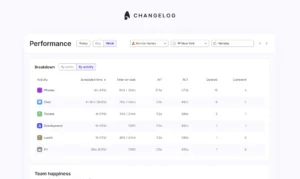
Summer Prep: Tips to Keep Your Support Team Running Smoothly

Summer is right around the corner which means that your contact centre is going to be under a lot of pressure. Make the most of the summer months by preparing your team for peak seasons.
Most contact centres experience wide ranges of volatility. Either you’re in a sector like travel or mobility where the summer is extremely busy, or you might be in e-commerce and retail where summer is a great opportunity to prepare for winter peak that starts around Black Friday.
In either case, preparing for your summer peak or using summer as an opportunity to prepare for your winter peak presents exciting opportunities for your service team.
Planning in advance to turn workforce management into workforce optimisation
There is nothing worse than having your service team caught off-guard with a massive wave of inflow. That’s why we’ve built Surfboard: the tool to help you navigate these waves and not get caught drowning underwater (as you can tell, we love the surfing metaphor).
With good forecasting and capacity planning in place, you have the chance to get in front of things and have enough people working on the right things at the right time.
In an industry that gets busier in the summer, also known as the summer scaries, good forecasting means you can ensure you have enough people to avoid providing a bad customer experience.
Good forecasting unlocks a number of opportunities for brands that experience busier than usual customer service traffic in the summer:
- Allocating shift plans well in advance so your team knows when they might have to work overtime or weekends to avoid building up a backlog
- Setting up your outsourcing partners or BPOs so they guarantee enough capacity so you can hit your service levels
- Adjusting your service levels to still delight customers with quick responses but at a manageable cost
- Working with part time employees to have enough people to fill your peaks. If your busy season is summer, this aligns well with working students. If you’re working with flexible employees, it’s important to identify your requirements and hire well ahead of time so you have enough time for training to maintain your CSAT.
If summer isn’t your busy period, it’s still a great opportunity to get ahead of the upcoming winter and use the downtime effectively.
For teams that are evaluating new tooling, processes or metrics, it’s an opportune time to implement new systems before things get too hectic.
If you see that you have more hours in the day with less inflow, this is a great time to invest in training, development and having your team get ahead on projects that ultimately make your service team run more efficiently. These could include building new chatbots and automations, documenting processes and issue trees or running assessment centres to hire new team members ahead of your busy season.
Utilising remote opportunities and a hybrid workforce
We’ve written previously on managing a hybrid service team. A hybrid and / or remote team unlocks opportunities to match your peak demand by increasing the available talent pool you can draw from. This means you are no longer confined to who can get to your office. With cloud based solutions and systems that work well with a distributed team, especially workforce management, you can much better plan for a busy summer season.
The most important thing is knowing who is available. With good tooling, your agents can input their availability or preferred working hours. When their availability matches when you need more people, you have the ability to flex up and down staffing based on the demand you experience from your customers whilst giving your agents adequate notice.
With Surfboard, your agents can use our Block feature to block out when they don’t want to be scheduled or aren’t available. We truly believe in giving agents more flexibility, and this is one small feature that unlocks flexibility for both sides.
Understanding all your options for additional support in a peak season
You want to delight customers with fast response times at the lowest cost to serve. And you want to do this in a way that avoids burnout in your team. We know this is hard to achieve, and that’s why Surfboard believes happy teams make happy customers. If you don’t plan ahead for your peak season and expect your team to work more hours or to squeeze more productivity out of them, you will see increasing rates of burnout. Our research tells us occupancy that exceeds 80% results in burnout, negative impacts on mental and physical health, and churn. You also don’t want to leave your customers waiting longer than desired because a bad experience will result in a low CSAT and possible churn.
So what are your options? These come down to two inputs: managing customer expectations or increasing resourcing. The tradeoff and decision you make will depend on how you assess customer experience and expectations against cost.
You may want to consider briefly adjusting your target response times, or SLAs, to manage these peaks. Using a model such as the Erlang A model to assess patience level of your customers and what their threshold is before abandoning a call or leaving a negative CSAT score will help you determine their tolerance level. If in normal times you respond to customers within 30 seconds you might be able to briefly increase your SLAs to one minute. It’s always good to manage customer expectations on your website and in email communications so they know you are experiencing high demand. An IVR alone is not a good experience.
The other option you have is to increase resourcing. There are different options you have here based on your budget limitations.
- Increase your team size by hiring and training ahead of time. This is the most costly option since it requires hiring a full time team. This option is right for you if you are going to have consistent needs for a team and it’s really important to maintain quality.
- Work with part time or freelance agents. This gives you the most flexibility and also maintains control over quality. This is best executed if you hire your part time in advance and spend enough time training them with quality assurance processes in place.
- Work with BPOs (outsourcing agencies). If you don’t already have an agreement with an outsourcing agency in place, this is difficult to get up and running on time. If you do, you’ll need to give them your capacity requirements in advance so they can guarantee your required headcount. Based on your budget constraints, you might decide to onshore, offshore or work with flexible staffing companies such as Yoummday.
Each option requires advanced planning which is why we recommend you have workforce management software in place ahead of your peak season.
WFM software that eliminates the headache of peak periods
Whether summer is a peak or trough in terms of your contact volumes, getting planning software in place beforehand is a worthwhile investment where you will see a positive return on investment within your first month.
Surfboard is built with full flexibility from day one to make sure you know what you need to manage your peaks or can have your team work on a variety of tasks if you are in a less busy period.



